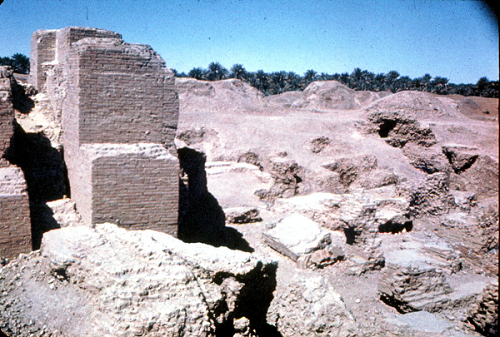September 26, 2003.
The top-selling “Left Behind” series envisions a lavishly rebuilt Babylon as the headquarters of Antichrist. In spite of the fact that the Bible says the opposite, many prophecy teachers today claim the Bible predicts a rebuilt Babylon. Since no Bible verse makes such a prediction, what is the basis for this claim?
A frequently claimed basis is found in Jer. 50:40: “As God overthrew Sodom and Gomorrah… so shall no man abide there.” It is true that Babylon was never burned up suddenly and completely with fire from heaven like Sodom. It is also true that Babylon’s ruins have had some inhabitants at various times in the last twenty centuries. Therefore, according to the argument, this prophecy was never fulfilled; and consequently, Babylon must be rebuilt so that it can be destroyed exactly “like the Bible says.”
There are serious problems with this type of interpretation. First, it does not take into account that comparisons have limits. In Amos 4:11, for example, God said of Israel: “I have overthrown some of you, as God overthrew Sodom and Gomorrah.” There is no record of any city of Israel being destroyed precisely “as God overthrew Sodom”–a total city and all its inhabitants burned up. Is God’s statement false? Not at all. God brought great destruction “like Sodom,” but not in every detail. For further discussion of comparisons, especially related to Babylon, go to Insight #75.
Second, such interpretations make no allowance for exceptions. The claim is made that if anyone ever lived in Babylon’s ruins, the prophecy was not fulfilled. However, the absolute-no-exception interpretation of Scripture is very often contrary to Scripture. For example, Scripture says, “For all have sinned, and come short of the glory of God” (Rom. 3:23). If there are no exceptions, Jesus was a sinner! God forbid! For further discussion of exceptions and how they relate to Babylon, go to Insight #77.
Like the proverbial “he can’t see the forest for the trees,” many prophecy teachers emphasize selected details of prophecies about Babylon, while ignoring the big picture. Any interpretation of details that contradicts the big picture has to be a false interpretation. What is the big picture surrounding Jer. 50:40?
1) Jeremiah lived to see the destruction of Jerusalem by Nebuchadnezzar, king of Babylon. In his days, Babylon reached the height of its world-renowned glory and power. “Babylon” is named in 265 verses of the Bible, over half of which are in the book of Jeremiah. The 110 verses of Jer. 50-51 are totally dedicated to God’s judgment on Nebuchadnezzar’s Babylon.
2) These 110 verses clearly predict that Babylon would become heaps, would never be inhabited, and would sink and not rise. There is no hint that Babylon would be rebuilt–quite the opposite. God was going to destroy the Babylon that existed in Jeremiah’s time and it would never be rebuilt.
The prophecy closes this way: “Jeremiah wrote in a book all the evil that should come upon Babylon… And Jeremiah said to Seraiah, When you come to Babylon, and shall see, and shall read all these words; then shall you say, ‘O Lord, you have spoken against this place, to cut it off, that none shall remain in it, neither man nor beast, but that it shall be desolate for ever.’ And it shall be, when you have made an end of reading this book, that you shall bind a stone to it, and cast it into the midst of Euphrates. And you shall say, ‘Thus shall Babylon sink, and shall not rise from the evil that I will bring upon her.’ ” (Jer. 51:60-64).
That is the big picture: Nebuchadnezzar’s Babylon, “this place,” was going to “sink, and shall not rise.” In the middle of the second century A.D. the Greek traveler and geographer Pausanias wrote: “At Babylon the sanctuary of Belus still is left, but of the Babylon that was the greatest city of its time under the sun nothing remains but the wall” (“Description of Greece,” 8.33.3). Other details of Babylon’s “heaps” (Jer. 51:37) from the second to the twentieth century are found in Insight #72.
It is a fact of history that Nebuchadnezzar’s Babylon lay prostrate in utter ruins from the second to the twentieth centuries. Babylon without doubt sank. When prophecy teachers speak of the “rebuilding” of Babylon, that “Babylon will rise again,” and “The Second Coming of Babylon” (the title of a recent book), their own words are an admission that the Babylon of Jeremiah’s time did sink. But God added that after sinking, Babylon “shall not rise.” Saddam Hussein did not change that (see Insight #113), nor will Antichrist change that. God has spoken.
